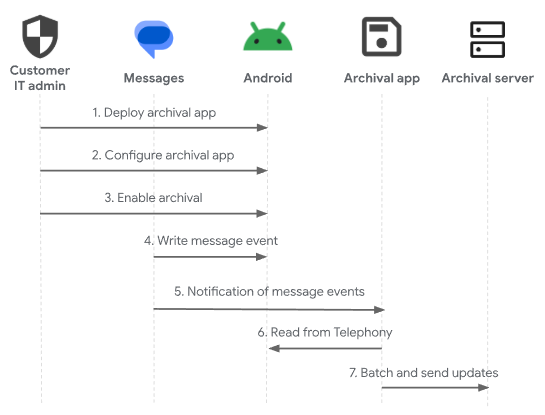Background
This document outlines how to integrate with, test, and validate the RCS archival feature in Google Messages.
Solution overview
- Client-side archival: Archival vendors need to develop an Android app for IT admins to deploy on their managed devices.
- Powered by Google Messages: This feature requires Google Messages to be the default messaging app. IT admins can use Android Enterprise controls to enforce the default.
- Requires Android Enterprise: This feature is available only on fully managed devices.
Workflow

- IT admin deploys archival app using Android Enterprise.
- Optional: IT admin programmatically configures archival app using
Android Enterprise controls.
- Required:
- The archival app needs
READ_SMSpermission
- The archival app needs
- Recommended:
- Disallow user control over Google Messages and archival app
- IT admin enforces Google Messages as the default SMS/RCS client
- Optionally, IT admin can pre-enroll archival app using MCM as well, if archival solution supports MCM
- Required:
- IT admin enables archival in Google Messages using MCM.
- Google Messages writes message data to Android on message events. A message event is one of: message sent, message received, message edited, or message deleted.
- Google Messages notifies archival app of new message event, for both RCS and SMS/MMS messages.
- The archival app reads the message data from the
Telephonyprovider. - The archival app batches updates and sends them to the server.
Implementation
Google Messages MCM schema
Archival is configured in Google Messages using the messages_archival key,
which accepts a string value for admins to specify their archival app by package
name. If the value is empty, null, or the key is not present, archival is
disabled. If the value is specified, archival is enabled, and Google Messages
sends an explicit broadcast to the specified package name on a message event.
Notification to archival app
- An explicit broadcast is sent to the specified archial app, with the action:
GOOGLE_MESSAGES_ARCHIVAL_UPDATE - In some cases, the message URI is included in the broadcast extras, which can
be used to fetch the message that triggered the broadcast:
com.google.android.apps.messaging.EXTRA_ARCHIVAL_URI
Archival app requirements
Required:
- Claim the FOREGROUND_SERVICE permission.
- Declare a foreground service in your manifest, which includes the intent filter for the archival update broadcast, and is permission-granted to assure only Google Messages can start the service.
<service
android:enabled="true"
android:foregroundServiceType="shortService"
android:name=".TestService"
android:exported="true"
android:permission="android.permission.WRITE_SMS">
<intent-filter>
<action android:name="GOOGLE_MESSAGES_ARCHIVAL_UPDATE" />
</intent-filter>
</service>
- Implement that service to handle the intent, read from telephony, and determine the type of the message event by comparing the prior state of telephony with the current state, and then cache both the message event to be uploaded to the archival service backend, and the updated state of Telephony to compare against on the next event.
Recommended:
Batch updates of message events to the server with
JobScheduler.- IT admins can guarantee your app isn't killed or your app data deleted by users, making sure your batched updates can proceed as expected.
- Minimizing foreground service time to just the critical archival requirement minimizes UX and system health impact.
Enable programmatic configuration of your app using MCM (as mentioned in Messages MCM schema), so users don't need to sign in or specify server enrollment details manually.
Testing
To test your implementation, use TestDPC or your preferred EMM client.
